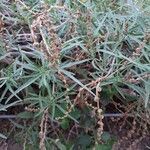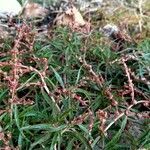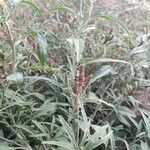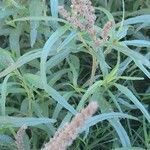Annual herb, up to 1 m high. Stems decumbent or erect, pubescent at least when young. Leaves with blade linear to narrowly linear-ovate, broadest above middle and ± narrowed to an obtuse apex. Flowers: inflorescences always prominently a terminal, branched or spike-like panicle; female perianth segments narrowed to a fine, subulate acumen 0.75-2.00 mm long; perianth green; Jul.-Jun.
Perennial herb with prostrate or ascending stems, branches 150-400 mm long. Leaves linear to linear-lanceolate, not wider than 10 mm. Inflorescence a terminal branched or spike-like panicle. Fruits muricate. Flowers green.
A herb.








